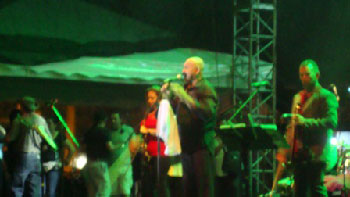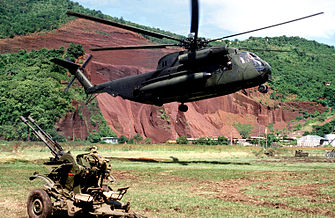Cuba, Grenada & Oscar de Leon: Thirty Years Later
Alfredo Fernandez

HAVANA TIMES — If someone had come to me three months ago (when I moved to Ecuador’s Amazon region) and told me I would get to see Venezuelan singer Oscar de Leon perform for free, I would probably not have believed them.
On June 20th, Ecuador’s province of Sucumbios commemorates the founding of its capital, Canton Lago Agrio. On this occasion, the city staged a number of performances as part of these official celebrations. The evening festivities, which lasted several hours and saw the participation of local artists, were enlivened by the presence of de Leon, popularly known as “The Salsa Devil”.
Following a lively fireworks display, the stage was taken up by the musician who had taken Cuba by storm some thirty years ago, a fact that is all the more impressive if we recall that, at the time, the country’s spirits were not exactly high.
In 1983, when I was still a child, I was, naturally, absolutely oblivious as to why America’s impenetrable bastion of socialism had opened its doors to an artist of the ilk of Oscar de Leon, to someone whose sympathies towards the Cuban regime weren’t exactly pronounced, and whose pronouncements at the time, statements such as “Look after yourself and leave me alone, let me defend myself as I see fit,” would prompt more than one attack by the local press, indictments such as “that, in essence, is the behavior of man under capitalism”, or so I recall.
The violent events in Grenada had taken place only a few days before Oscar de Leon set foot in Havana’s Jose Marti airport. On October 12, 1983, Marxist head of state Maurice Bishop had been removed from office by Grenada’s Central Committee, headed by Deputy Prime Minister Bernard Coard, who was also a Marxist but opposed to the excessive personality cult that surrounded Bishop and the equally excessive presence of Cuban officials in all of Grenada’s government institutions.
Coard, who sought the establishment of a collective rather than a one-man leadership, invited Bishop to abandon Grenada. Bishop refused and was detained in his home on October 13.

Following this incident, in circumstances that have not yet been clarified, Cuban military and technical personnel based on the island freed Bishop and relocated him to Fort Rupert, the general headquarters of Grenada’s armed forces. No one knows exactly what happened within the walls of Fort Rupert. The one thing we know for certain is that Bishop did not come of the facility alive, and that his body was never recovered.
US President Ronald Reagan, fearing Soviet expansion in the Lesser Antilles, declared that 400 American students then on the island had been kidnapped, using this as a pretext for a military action.
Reagan proceeded to launch Operation Urgent Fury, aimed at taking Grenada through military force and removing the Marxist government from power. By October 26, 20,000 soldiers from the 82nd US Air Force Division had taken over the island.
At the time, a brigade of Cuban construction workers was building a large-scale international airport in Grenada. In total, some 784 Cubans were based on the island. When the U.S. government announced the imminent invasion, all nations withdrew their diplomatic personnel from the island – all save Cuba, which, on instructions from Fidel Castro, and against all logic, would send a high official to Grenada, with orders to prevent, with the Cuban construction brigade and some forty Cuban soldiers, the taking of the Saint Georges airport by US forces.
The military officer selected for this kamikaze mission was then Colonel and Central Army Chief of Staff Pedro Tortolo Comas, a man who had graduated with honors from a Soviet military academy and was an expert in tank maneuvers.
He was being sent to a battle where he would have to make do without his weapon of choice, to lead an army, not of soldiers, but of construction workers without any military experience whatsoever.
Tortolo and his “army” of some one thousand men were tasked with no small feat: not only were they expected to confront rangers and marines from the United States’ 82nd Air Force Division (in a small island devoid of any geographic elevations), but also prevent the Punta Salinas airport from being taken by an army equipped with the latest weapons.
One need not be particularly perceptive to deduce, from the above, that what Fidel Castro wanted at the time was for the Cubans based in Grenada to sacrifice themselves en masse. This would prompt the international community to condemn the US intervention, and he would then be able to turn the tragedy into a political victory.
In addition, and most importantly, this incident could be used to turn the antipathy felt by Cubans towards Americans into insuperable hatred, and to turn relations between the two nations into something akin to those between Arabs and Israelis.

Why else would Fidel have selected Colonel Tortolo, who was in Cuba at the time, and not Colonel Mendez, who was already based in Grenada and was the head of Cuba’s small military contingent there?
The answer to this question is to be found in the physical attributes of these two men. Mendez was a white, short and stout man. Tortolo, on the other hand, was a well-built black man, whose appearance was much closer to the stereotype of the warrior than Mendez’. Fidel, in fact, would compare Tortolo to Anotonio Maceo (a black Cuban independence hero).
Upon arriving at the battlefield, Colonel Tortolo realized he had been sent on a suicide mission – that he was being asked to lead the slaughter of Cuba’s military personnel in Grenada.
In an act of maturity, Tortolo disobeyed his orders and saved the lives of more than 700 Cubans. Lenin’s military maxim, that “in a war you either advance or retreat”, was the insight that led Tortolo to retreat and avoid a needless slaughter.
His request for protection from the Soviet embassy and his subsequent return to Cuba dealt a double blow to Fidel’s credibility. First of all, Tortolo had demonstrated that one did not always have to obey Fidel’s orders, particularly if these put people’s life at risk.
Second of all, he had completely ruined Fidel’s plans of creating an unprecedented political crisis for the Reagan administration.
As a result of the one attempt at resisting the invasion, 24 Cubans died and 59 were wounded.
The testimony that construction worker Mario Martin Manduca later provided would be used to disparage and denigrate Tortolo, who would go down in Cuba’s cultural imaginary as the quintessential coward.
Back in Cuba, a wheelchair-bound Manduca declared that “Tortolo was at my side when the bomb that damaged my legs exploded. I didn’t see him again afterwards.” It’s curious how no one thought to ask Manduca how Tortolo, who was standing next to him, managed to walk away from the explosion unharmed.
Tortolo’s character assassination reached such extremes that there was even a scathing popular folk song dedicated to him in the eighties:
When you’re going far, when you’re going high,
if you want to keep running rather than die,
then Tortolo tennis shoes you should buy.
Another piece of unverified news that Cuba’s Granma newspaper published about “the last redoubt of Cuba’s resistance in Grenada” related that “six Cubans had sacrificed themselves, embracing the flag.”
Though these images were never broadcast in Cuba, they were the cause of much sadness among the population. What’s worse, the effect they had was the opposite of what had been expected: in secret, people would ask why the Cubans based in Grenada hadn’t been airlifted out before the invasion.
This rather sensitive question would become the key that opened Cuba’s doors to salsa music star Oscar de Leon.

For, while Tortolo had already been turned into the scapegoat, now, as in the failed sugar cane harvest of 1970, the government needed to skirt the people’s prying questions, which, back then, focused on why a 10 million ton harvest had been planned if such a goal was impossible to reach.
Back in 1970, what Fidel had done to steer people’s attention away from the frustrating failure of the “10 Million Ton Harvest” was to organize the most flamboyant carnivals Cuba has ever witnessed since the triumph of the revolution, the “1970 Carnivals.”
After Grenada, it was Oscar de Leon’s turn, and the “Salsa Devil”, a popular artist with folksy high spirits, playing musical numbers that appealed to the festive spirit of the average Cuban, managed to pull the nation out of its funk in a matter of days.
With the merry refrain of “gimme some cable, Valentin” and the number entitled “Mata Siguaraya” (sung at the close of all of his performances), the salsa music idol made Cubans forget what had happened in Grenada and restored them to their natural, carefree state.
As a result of the events in Granada, the bit of lyrics from Oscar de Leon’s song (“gimme some cable”) and the phrase “Tortolo shoes” were incorporated into Cuba’s popular imaginary. The first was deployed, with a new meaning, as the slogan of a campaign calling for unrestricted Internet access, launched by a handful of courageous Cubans. The horrible ditty about Tortolo shoes, in contrast, disappeared with the collapse of the socialist bloc.
It will soon be thirty years since Cuba welcomed Oscar de Leon, the foreign artist who stirred up Cuban crowds like no other.

Whose history? White people who think they have all the answers for Cubans and other people of color throughout the world. In Chicano history, Fidel will receive the positive recognition–not blind love–he deserves.
It is interesting that Alfredo mentions that Cubans were involved in freeing Bishop from house arrest after Bernard Coard seized power. The wiki entry does not describe how Bishop was freed or by whom, nor how he was later killed:
“On October 14, 1983, a party faction led by Deputy Prime Minister Bernard Coard seized power. Bishop was placed under house arrest. Mass protests against the action led to Bishop escaping detention and reasserting his authority as the head of the government. Bishop was eventually captured and murdered along with several government officials loyal to him. The army under Hudson Austin then stepped in and formed a military council to rule the country. The Governor-General, Paul Scoon, was placed under house arrest. The army announced a four-day total curfew where anyone seen on the streets would be subject to summary execution.”
There is also some clarification as to the true nature of the Cuban construction team:
“Some of the “construction workers” were actually a detachment of Cuban Military Special Forces and combat engineers.[21]”
Yes, That’s what happened in Grenada. By the way, that was a great article.
I had never read this version of events regarding Grenada. For Americans, it was a rescue mission and of little import. In fact, it was only after Clint Eastwood made a movie based on these events years later that most Americans really paid any attention to what happened. Castro’s willingness to sacrifice fellow Cubans to serve his political purposes is disgusting and just another example of why he will not be treated kindly by history.